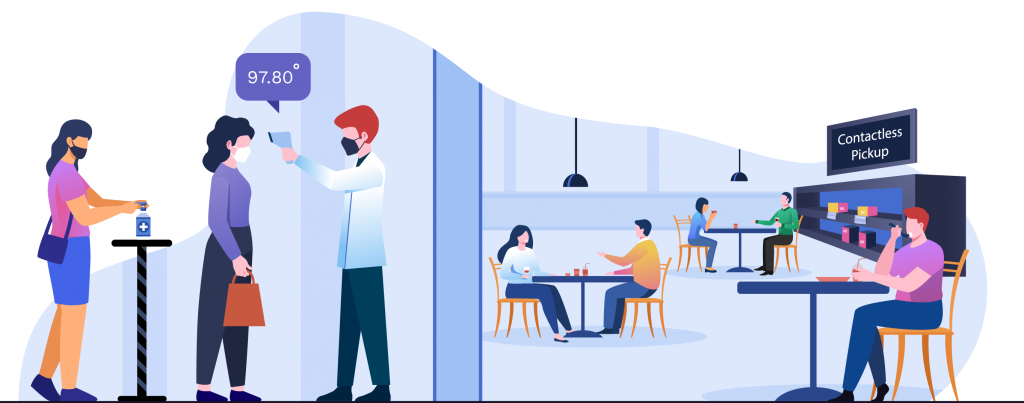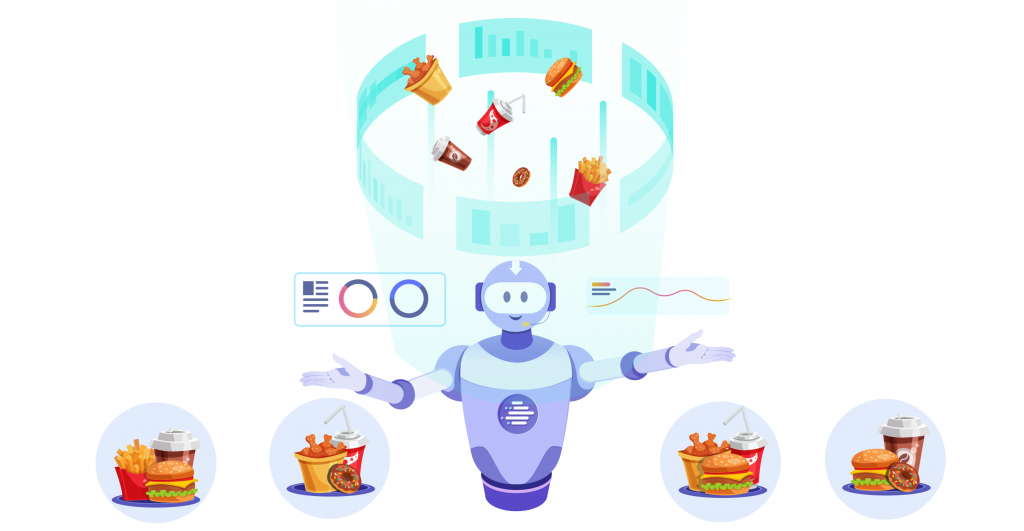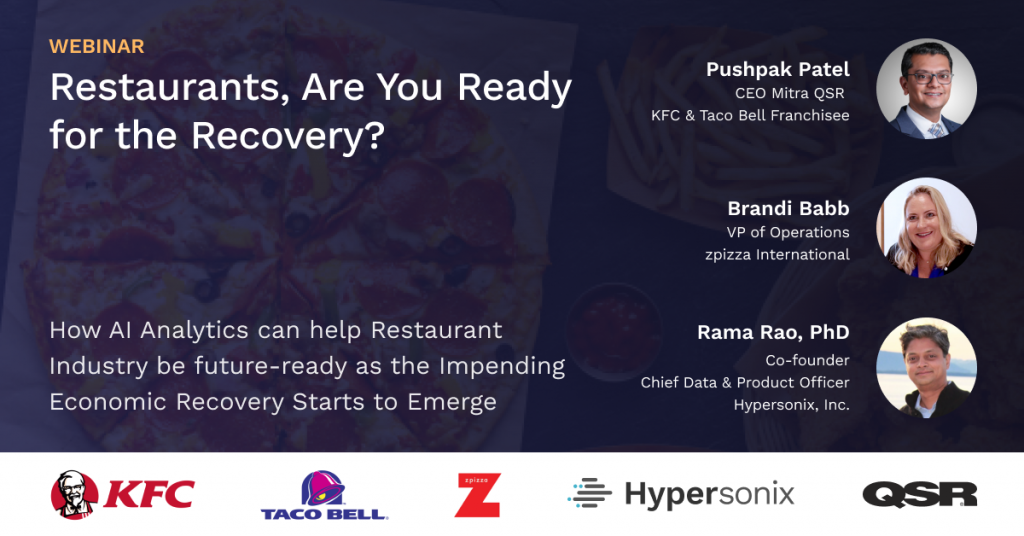Serving the new normal on a plate with AI in Restaurants
Serving the new normal on a plate with AI in Restaurants
“When the winds of change blow, some people build walls and others build windmills.”
– Chinese proverb
With around 16,000 permanent closures in the US, the restaurant industry has been among the worst COVID casualties. But does that mean it will cease to exist in the post-COVID world? Of course not.
Restaurateurs have a good reason to be optimistic and start preparing for the boom. The signs of economic revival, however faint, have started appearing with economic activity and employment picking up in recent months.

The slowdown presents a unique opportunity, giving you time to pivot, prepare, test, and jump-start operations.
In this article, we explore some of the facets of the impending change and the role of AI in restaurant industry as it prepares to emerge from the crisis.
What are the key drivers of changing market conditions?
While certain business drivers continue to change and define the long-term landscape, the most successful businesses have been quick to respond to changes in the short term. Here are a few key changes that restaurants continue to leverage to stay ahead in the game.
Changing Consumer Behavior
The situation today is undoubtedly unprecedented, and several restaurants have already started reopening with tweaked menus, adjusted hours, added more delivery and takeaway options to keep the cash registers ringing.
Here’s a brilliant example. The fine dine model of Canlis went under the knife and came out as a drive-through, a bagel shed, and a family meal-delivery service – all in a matter of six days! They also built a new tech platform to handle deliveries without relying on a third-party carrier.

Not all restaurants have the advantage of a strong brand recall like Canlis – to pivot to a new model and still enjoy continued patronage. The solution lies in adapting to the change with innovation and technology.
Restaurants, in general, have access to a lot of consumer data and preferences. With an AI-enabled analytics tool sitting on top of the database, the restaurants can pivot to new models, or personalize services, better suited to their target audience. Personalized home delivery menus? Why not!
AI in menu optimization can help cut down on food waste by de-listing items slow-selling, high-cost and low ROI items, based on local dynamics. AI in restaurants can thus help you fend off the biggest challenge to a healthy bottom-line.
Legacy Technology Problems
Even the most tech-savvy businesses use legacy restaurant analytics softwares that offer little in terms of actionable insights. To keep up with rapidly changing data points, traditional restaurant analytics needs to be supplemented with AI-integrated solutions, which can work with little historic data.

While artificial intelligence in the fast food industry has been in use for quite some time, the same cannot be said for other dine-in formats. Today, popular applications of AI include personalized menu suggestions and taking voice orders. However, its application in analyzing data and forecasting demand, so far, has been considered to be relatively limited.
With advanced capabilities to analyze consumer demand, AI-based product bundling can help restaurants come up with new combos using the existing menu items. It kills two birds with one stone –
- It offers more choices to the consumer, without straining your supply chain or investing significant time in training you kitchen staff
- It helps you increase the average check value, as AI creates combos that are likely to sell more.
As consumer preferences change rapidly today, AI-driven solutions deliver unparalleled speed and time-to-insight, allowing you to leverage instant insights and recommendations that directly impact your bottom line.
Many of our customers in the Consumer Commerce space continue to find success with these advanced capabilities delivered by Hypersonix. It’s credible proof that AI is capable of delivering what restaurants need today. It’s just a matter of finding one that’s purposely-built to cater to those needs.
Inadequacy of current approach
Apart from upgrading their analytics technology, restaurant businesses also need to adapt their approach to changing business environments. The current approach is marked by a lack of willingness to invest in the future. Thin margins are often cited as a reason for sticking to traditional tools and not investing in the future.
To succeed in the post-pandemic era, restaurants have to quickly adapt to changing patterns. A few may be short-term changes and reversible in nature – like printing the body temperatures of all their team members on takeaway/delivery packages. Others may be long-term changes – both reversible and irreversible.

Notably, this calls for investments on multiple fronts of the business. Any hesitation or delay would have a direct and disproportionate impact on business, as the competition may go all out to tap into the pent-up demand.
Inertia and resistance to change
Good times make tough decisions difficult; if it ain’t broke, why fix it? In the face of the economic recovery, running on full capacity, most restaurateurs would be too busy serving guests to think about incorporating the new AI technology or upgrading their analytics software. Simply put, the likelihood of addressing systemic issues will diminish as the economy accelerates.
If you are looking for inspiration or proof-of-concept, see what the big guys have been doing.
Even before the pandemic, a few players largely because of massive scale of operations were quick to jump on to the AI wagon; and the gains are evident. If nothing else, the seamless AI powered consumer experience they offer is there for everyone to see.
While AI driven product bundling, menu suggestions are something that most of us are aware of, do you know AI can significantly increase your operational efficiency? For example, AI based rostering can help you manage shifts, prevent employee burnout and augment your efficiency to handle golden peak hours.

AI can also help you with critical decisions that are dynamic in nature. For example, today pricing decisions need to be more dynamic because of the massive economic shift that has occurred. AI driven pricing will factor in macro-economic conditions, consumer demand, location and help you tread the line between building a strong top line and maintaining a healthy bottom line. Best part? With real-time insights you can make required changes to maintain optimum average check value all the time.
So, it’s high time to stop kicking the can further down the road. There is never going to be a better time; the hard decisions to survive and grow need to be made now.
Path to Success
An often-ignored perspective of the pandemic is how it has levelled the ground for all players across industries – virtually everybody’s out of business. It’s the perfect opportunity to close a few gaps that have historically existed. The relatively smaller players can use this slowdown to leapfrog the competition.
If you are sitting on the fence undecided about which way the situation will head, you still need to act. You must put a game plan together for either of the two possible scenarios.
Protracted Recovery Scenario
If you believe the recovery is still some time away and, until then, survival is your primary goal, you need to invest in technology infrastructure that helps you avoid the cost of wrong decisions. Legacy restaurant analytics software with insights based on mechanical logic (of simple algorithms), may prove to be the nemesis of your business.
On the other hand, an AI-based solution will consider several variables and offer you intelligent insights and recommendations to make the right decisions. It would have the capabilities that traditional restaurant analytics companies may not have been able to build in the past.
Delaying investment in AI based decision-making infrastructure to save money would be a penny-wise and pound-foolish move.
Immediate Recovery and Vibrant Business Scenario
With the advances made in the discovery of vaccine, there’s a good reason to believe 2021 is going to be a terrific year for business. In such a case, you need to gear up for managing growth in every form.
Dealing with multiple unknown variables – changing buying patterns, macroeconomic environment, customer interaction with different sales channels – AI can help you predict the new form of business. You can be better prepared to make efficient plans and effective decisions, if you invest in the right technology now.
Winner or Survivor?
Signs of the economic boom and unshackling of consumption are already visible. The business will go on, perhaps, acquiring a new shape and form.
As a leader, you are presented with an opportunity to shape the future of not just your business, but the industry at large. You can choose to be a pioneer of the change and benefit from the recovery whenever it happens or be a victim of circumstance.
Everything boils down to the decisions you make today. With real-time insights and proactive alerts, AI enables you to make the right decisions faster.
Time is a luxury that the pandemic has taken away. But, it has presented us with an opportunity to level the ground and catch up with those ahead of us by delivering powerful, unparalleled experiences with real-time data.
In our recent webinar with QSR Magazine, we discussed how top restaurants like KFC, Taco Bell and zpizza approached post-COVID recovery with AI-Analytics Solutions for a successful comeback. It is now available on demand.







